- All Posts
- /
- 10 of the best COVID-19 marketing ideas we’ve seen

10 of the best COVID-19 marketing ideas we’ve seen
Messaging and Automation-
 Stephanie Knapp
Stephanie Knapp
-
Updated:Posted:
On this page
Businesses are constantly evolving, but companies have been met with swift, sudden changes as a result of the COVID-19 global pandemic. Every industry has been touched in some way by the virus, companies large and small.
iPhone shipments will likely decrease by as much as 10% as members of their supply chain have been affected by the virus, and one in four businesses have shut down temporarily in response to COVID-19. The economic impact has the possibility of being large, with 46% of U.S. companies believing it will take six months to a year for the economy to recover.
As devastating as the virus has been, there is still hope for organizations to assess and adapt.
23% of businesses still believe they’ll hire employees in the coming year, and 57% feel positive about their overall business health. Some industries are even thriving. Coursera, an online learning platform, has seen traffic to their site increase four to five times above normal. Similarly, Instacart has witnessed a 150% increase in demand.
Some other industries that are thriving include:
- Cleaning services
- Pizza chains
- Drive-in movie theaters
- Grocery stores
- Wine and liquor stores
- Meal prep delivery services
- Canned and jarred goods
- Board games
While some companies are more poised to suit consumer needs during this time than others, we believe there’s always an opportunity for businesses to connect, innovate, and emerge stronger on the other side of a crisis.
In this post, we’ll cover COVID-19 marketing opportunities and ideas that can hopefully inspire and help you thrive during a crisis.
The upside to adapting during a crisis
This is undoubtedly a tough time for many people, but there is a silver lining here. The adaptations you make in your business now to cope with changing demand can help you for years to come. Here are a few benefits you’ll reap in the long-run.
You’ll discover new (and maybe more cost-effective) sales or delivery channels
There’s no time like the present to add or upgrade your digital or socially-distanced sales and distribution channels, now that most activity has moved inside and online. Some advertising platforms, such as Facebook, YouTube, and Google Ads, are also showing lower CPC and CPM rates.
Average cost per click rates are down to $0.089 on Facebook, which means it’s a cost-effective time to try new ad strategies or double down on top performing campaigns.
As every business adapts and experiments with new ideas, you may even find more cost-effective tactics.
You’ll be prepared for future changes
To be fair, it’s uncertain when or how the world will “return to normal.”
By taking time to audit your business now and create a solid base, though, you’ll be ready for changes ahead. One of the best things you can do for the future of your business is focus on top-performing strategies, and streamline where possible right now.
You’ll set yourself up for sustainable growth
While cutting expenses feels uncomfortable now, it may help to think of this time as an opportunity to audit your growth and sustainability. Right now, you should be looking at the ROI of your marketing and operations, and narrowing your focus on the most profitable tactics.
By going all-in on your best messaging and strategies, you can deliver a better customer experience where it matters most.
You can be bold with new ideas
With so many shifts occurring every day in all industries, all bets are off. As a result, now is the time to be bold. While being respectful in your messaging, get creative and launch new ideas. Experiment, have fun, talk to customers, and serve your community—if only for the adage “what have I got to lose?”
COVID-19 marketing ideas + strategies to inspire you
1. Airbnb takes travel online
Travel companies will no doubt feel the results of everyone staying home, since there was a 66% decrease in airport visits between February 19 and March 27. However, companies have found ways to adapt and bring the experience of travel online.

Airbnb launched Online Experiences, where you can pay to take a virtual wine class, see a magic show, or enjoy a concert. With this campaign, they’ve taken a segment of their business, “Experiences,” and made it location-independent. Lucky for Airbnb, “Experience” creators, and people at home, this trend could stick around even after the virus.
The experiences are also grouped by categories, such as “great for teams” or “up close with animals.” Any company can take this time to reorganize their content and segmentation to deliver better experiences across your website, push notifications, and email. You may also be able to bring older, but newly relevant, content up to the surface.
2. Meetup launched resources for hosting events online
While the event planning website Meetup doesn’t have native video streaming capabilities, they’ve still found a way to provide helpful content to their audience. A series of webinars and blog posts help Meetup’s customers adjust to hosting online events, instead of in-person.
By focusing on the real needs of your audience, and not just how they pertain to your platform, you can be an ally in difficult times.
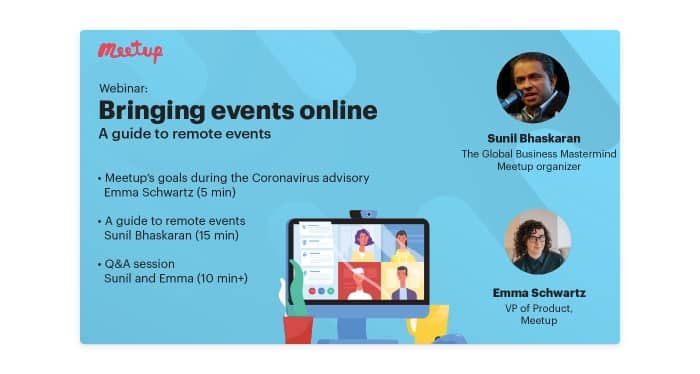
3. LastPass highlights how to use their tool at this time
If there are ways for users to take advantage of your tools in new ways, let them know! Mindful re-engagement campaigns based on user activity could be useful for drawing attention to your most powerful features.
LastPass used email to highlight a few relevant uses for their service. The content is a helpful emergency preparedness checklist, as well as a refresher on some of the company’s tools. Use this time to consider how your company fits into your customer’s changing life, and whether or not your most influential value proposition has changed.
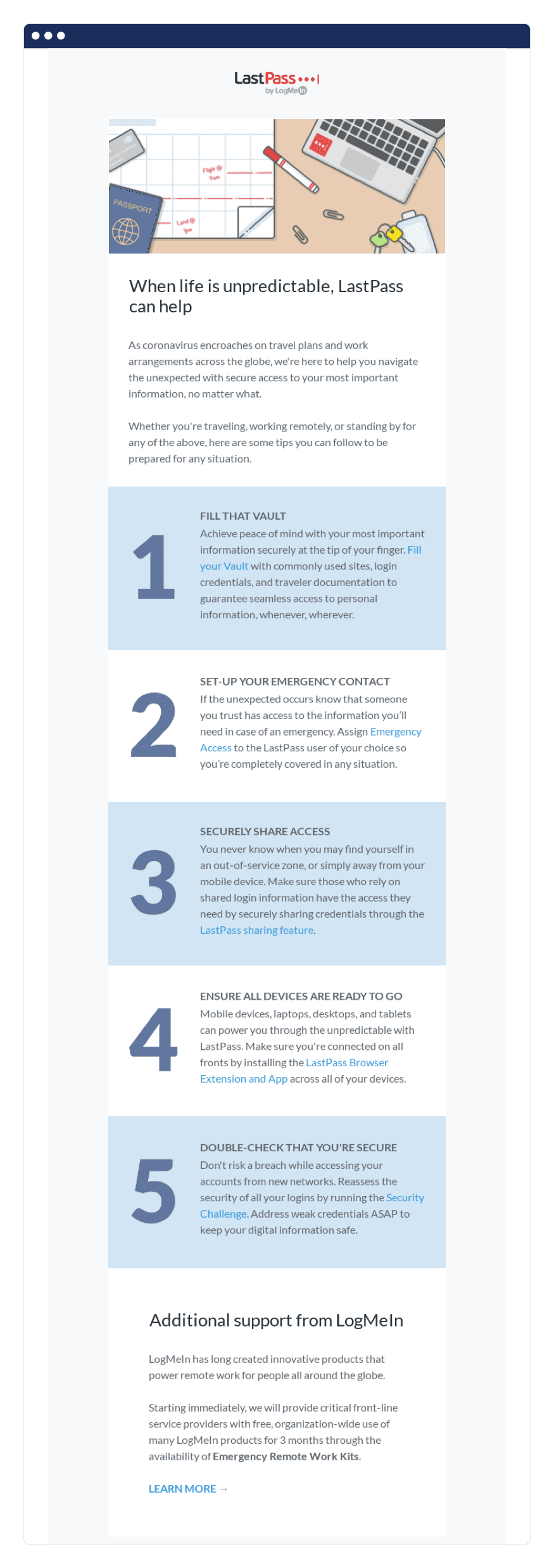
4. SEMRush opens access to relevant tools
While some companies are taking this time to highlight new ways to use existing features, others are creating or promoting applicable content. For example, SEMRush opened up access to tools that help marketers during this time, including a prospect finding tool and digital marketing academy.
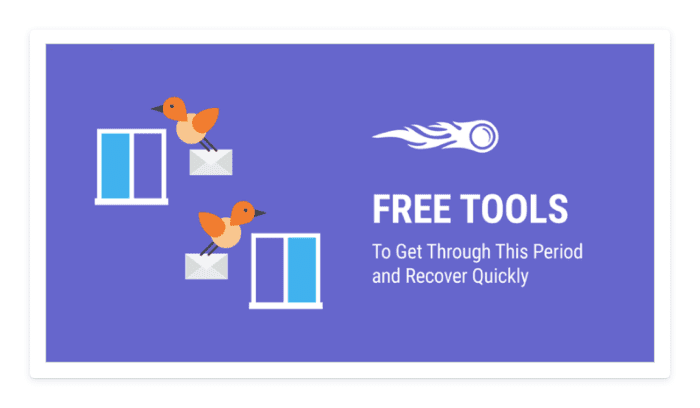
5. Gyms are creating online classes
Many in-person businesses, such as gyms, have turned to online video to reach customers at home. Planet Fitness has been live streaming “work-ins” on their Facebook page, and Gold’s Gym has released some of its in-app workout videos for free.
While these gyms may not be earning revenue from live streams or free videos, they are helping customers establish or continue the habit of working out and to keep their brand top of mind.
Which begs the question: how can you help customers develop habits now that will be beneficial for them, and revenue-producing for you, in the future?
Even activewear companies are getting in on the at-home fitness
video trend. Outdoor Voices uses email to drive traffic to live
streams, which complement their clothing line. 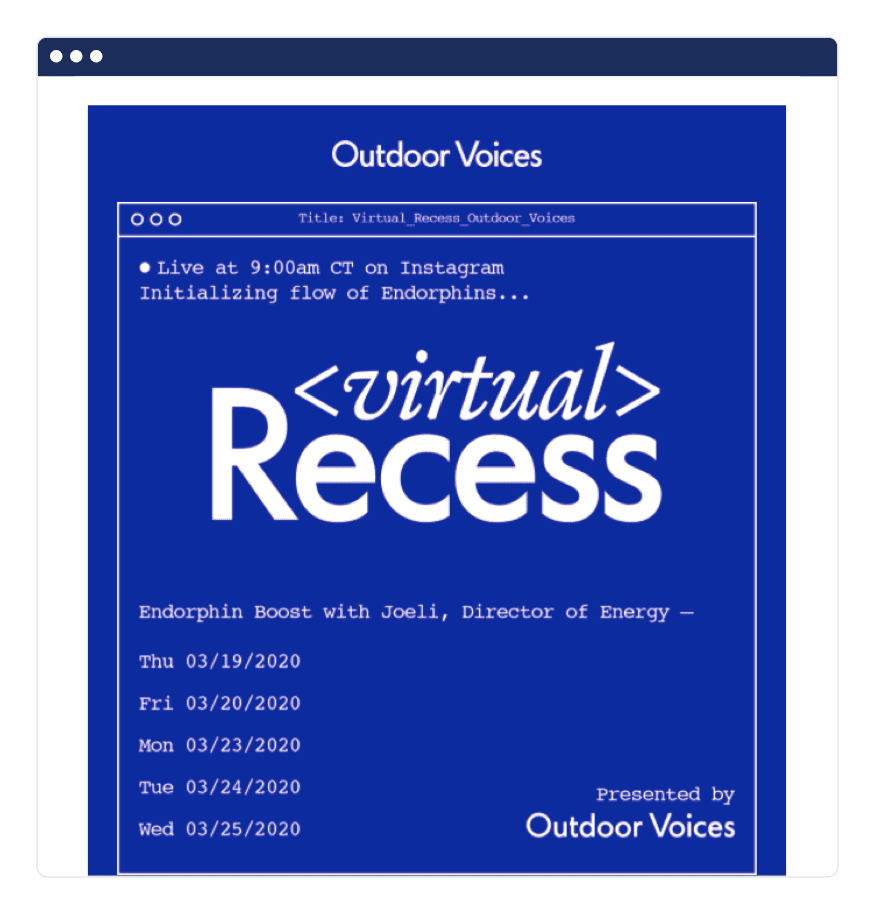
6. DSW launches an unlikely partnership
Unprecedented times call for thinking outside the box. Perhaps the most outside the (shoe) box collaboration to emerge is between shoe store DSW and a grocery chain, Hy-Vee. After the pandemic, DSW shoes will have a presence in grocery stores.
For now, DSW shoes are available on Hy-Vee’s website. The deal was in the works before the Coronavirus, but it’s a timely reminder to look for new sales and distribution channels.
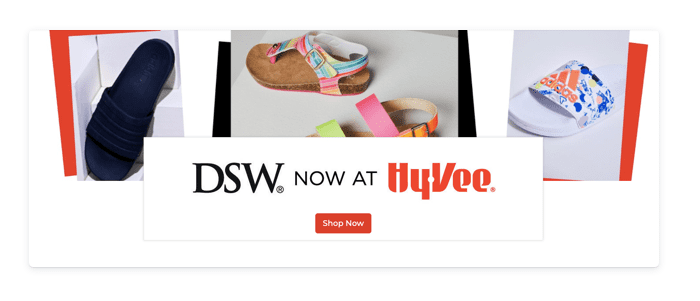
7. Tattly offers free shipping
If you’re worried about your revenue, giving stuff away for free seems scary. While you have to determine for yourself if it’s viable for your company, free shipping on things that could be useful, like craft kits, may increase demand enough to offset costs. Crafting company Tattly offers free shipping alongside a list of DIYs for families bored at home.
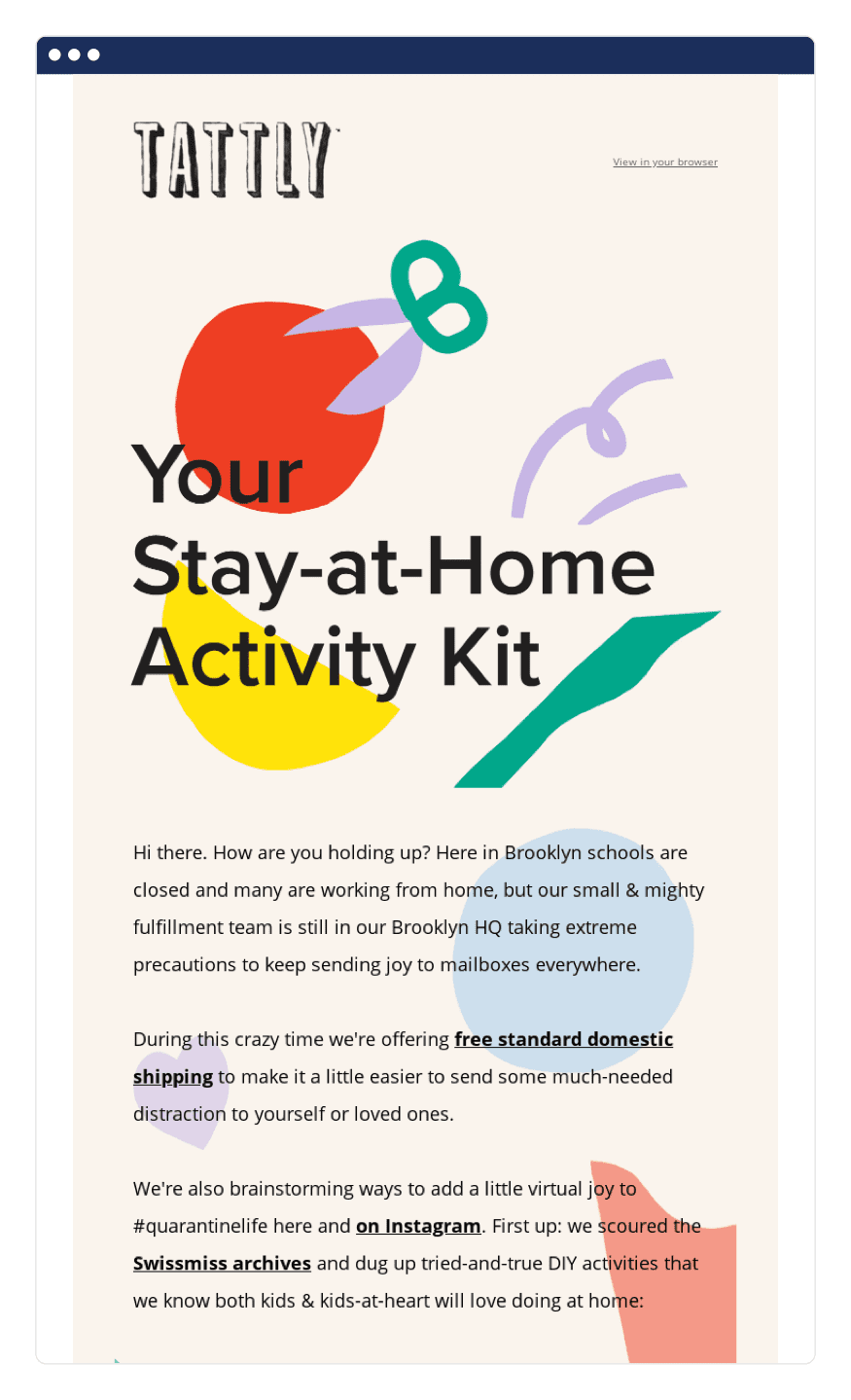
8. SleekNote creates a free tool
What if you don’t have a physical product to ship? Try to brainstorm a simple tool or lead magnet you could create. As an example, SleekNote created a free COVID-19 notification popup tool.
While your content and lead magnets should always be helpful, make sure that anything you create (and ask an email for) right now makes a noticeable impact for your customers. You don’t want it to seem like a flimsy grab at email addresses, especially during a difficult time.
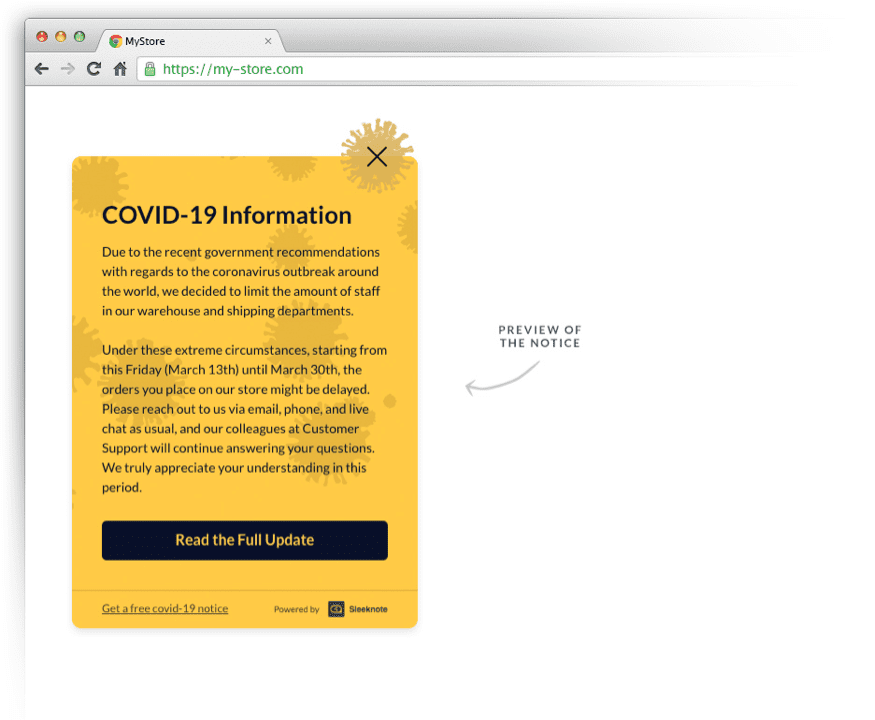
9. American Airlines gives back
While some companies, such as distilleries who are now making hand sanitizer, can make small changes to produce in-demand items, the path to lending a helping hand isn’t as clear for others. If you’re looking for a way to give back, consider partnering with a charity.
AmericanAirlines is partnering with the American Red Cross to raise funds for frontline workers.

To incentivize donations, AAdvantage members will earn flight miles for every dollar donated to the cause. This campaign will boost donations, as well as give customers a reason to come back to American Airlines to use up their points after the virus subsides.
10. Restaurants begin selling produce direct to consumer
Restaurants have perishable goods that can’t exactly sit and wait for COVID-19 to pass. So, many are pivoting and selling meal kits or product boxes directly to customers. End users get to enjoy meals from their favorite restaurants, and restaurants continue to support vendors and drive revenue while their front-of-house is closed.

Best practices for your COVID-19 marketing strategy
Some industries may make little to no change to their business, while others will need to get creative. No matter what industry you’re in, here are some best practices that you can take away from the examples above.
Think of ways to bring customers back when businesses reopen. If you can’t get sales or visitors now, what can you have them do that will entice them to come back after the virus? Some restaurants are selling gift cards to boost future visits, while American Airlines is giving away miles.
Help users establish good habits now. Think of ways to get customers in the habit of engaging with you now to maintain momentum throughout the virus. Host live streams or courses to make your company a part of their everyday lives.
Create content or resources to help customers. What free tools or content can you create or promote to help your audience? Or, can you repurpose past content into a new format, or leverage email automation?
Review your automated messages to reflect changes. If you’ve added a new tool, are highlighting specific features, or are running a promotion, you need to audit your emails to make sure all automated lifecycle email series are updated.
If you can, consider where you could offer more (or for free). Are there any features or offerings that you could temporarily reduce the price for to drive engagement? Make sure whatever you choose is valuable and likely to show a good return on signups.
Think outside of the box for partnerships, giving back, and content. Do you have overlapping audiences with a different business that could become a distribution partner or co-marketing campaign? Working with other companies can be mutually beneficial. Also, think about complementary content, such as activewear brands hosting fitness classes. Consider the context that you serve your users, and what related topics you can reach them through.
Tweak your plans or tiers to fit changing needs. If you’ve seen a new or surging customer segment emerge because of the virus, such as students using Zoom, it may be time to reevaluate your pricing plans.
Above all, root your COVID-19 strategy in supporting customers and adapting to help them with some aspect of their everyday lives.
While you may have to create new assets or quickly establish new distribution channels, your commitment to serving your audience, even if it means going out of your way, won’t go unnoticed.
Who knows, you may unlock the next big thing in your business! If you want to learn more about the next steps you should take to adapt your marketing, check out our guide on auditing your marketing and emails during a crisis.

